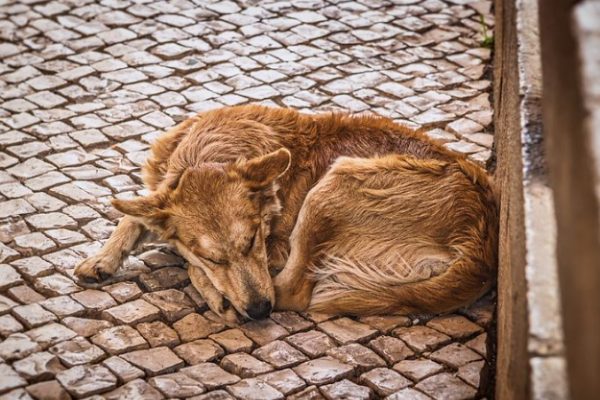15 Common Signs Your Dog Is Dying Of Old Age & How To Care

I have lost two dogs due to old age, so am here to share signs your dog is dying of old age because I have experienced dogs die.
What you get in this post is my experiences, online research, chats with other dog owners who lost their dogs to old age, and my chats with some veterinarians.
In this post, we will outline and discuss all the common signs that your pup is dying of old age which can be depressing to most dog owners.
Understanding the symptoms that a dog is dying is a tough subject for any dog owner, but it is critical to understand how to spot the usual signals that a dog is dying due to old age.
Signs your dog is dying of old age
The most typical indicators of a dog dying of old age are listed below:
1. Persistent shaking of both legs
Dogs are energetic pets who enjoy running about and following their people around, as well as leaping for goodies.
Your dog’s constant shaking of both legs is an indication that he or she is becoming weaker by the day.
Shaking both legs indicates that your dog is no longer capable of carrying on with his regular routine and would rather lie down.
Your dog’s legs can no longer hold the weight of the dog as they age, and the muscles are weak and old, causing both legs to shake.
As the muscles and cells in your body age, so do the muscles and cells in your pup legs, resulting in leg shaking.
2. Continues self-isolation or hiding
Self-isolation is one of the most typical indicators of a dying dog; while this might be distressing for some dog owners, knowing your dog’s demand for privacy is critical.
When a dog is nearing the end of his life, he always wants to be left alone since he has lost interest in everything.
Continued walking away from family members, activities, or sounds to a calm spot is a sign that your aged dog is coming to the end.
3. Excessive shedding on sleeping spot
This is something every dog encounter as they get to the end and can also be difficult for some dog owners as you may need to clean up regularly.
Dogs shed for different reasons, most of which can be fixed easily with the help of a veterinarian.
However, when your dog continues shedding excessively after treatment from your vet, the end is near.
When your aged dog gets up, and you see a handful of fur from where he got up, then the end is near due to old age.
Excessive shedding after treatment is a clear sign that your pup is dying due to old age and there is little you can do at this stage. There are common ways to control shedding in dogs.
4. Continues loss of coordination
The loss of balance and motor function is the next big symptom that a dog is dying of age, and there is little to what you can do about it.
If your dog does stand up and move about, he or she may appear shaky or confused, then the dog is losing coordination.
While laying down, they may tremble or convulse.
Put them in a limited, calm, comfortable space as much as possible, and eliminate anything they could bump into or knock over.
Saying goodbye to your dog entails safeguarding them, creating a secure environment for them, and providing them with any assistance they require.
5. Excessive reduction in mobility rate
As your dog ages, his or her mobility will deteriorate at a faster rate than typical.
The dog’s strength may deteriorate as he or she ages, to the point where he or she is unable to stand for as long as before.
Your dog’s legs may begin to weary, making it difficult for them to climb stairs or cross slick surfaces.
With time, your dog may lose the ability to stand and walk about, and some may even struggle to lift their heads.
A reduction in movement pace is one of the final phases before your dog gives up. This will be obvious, and you should anticipate seeing it.
6. Repeated and continues lethargy
The most prevalent symptom that the death process has begun is extreme lethargy in old age.
When your dog is dying due to old age, he may not have the energy to get up and answer when called by his name.
Lying in one place, frequently in a quiet place where they don’t usually lie, uninterested in toys or walks, rarely noticing family members, in other words, not acting like themselves.
Other health concerns might cause dogs to become sluggish, but if you’ve checked that out, and it persists for more than a day, it could be an indication that it’s time to say goodbye to your pet.
7. Repeated respiratory issues
Even after medical treatment, many dogs have recurring or frequent difficulties breathing at the end of their lives in terms of old age.
Their breathing may be irregular, with long intervals between inhaling and exhaling, and this might worse over time.
These are the most difficult times because you know they’re in pain and there’s nothing you can do to help.
Saying farewell to your dog during these difficult hours involves accepting that you have no control over the situation. You won’t be able to stop it.
8. Repeated house accidents
Incontinence, or the inability to regulate urinating, is a common condition in senior dogs.
Taking your dog to the vet when a house accident occurs can be helpful from the onset as time goes by, the vet may have little to do at the ending days.
In general, if your dog is having incontinence but is still acting normal in other ways, such as having energy, playing about, and being cheerful, then it is likely not towards the end of its life.
There is nothing you and your veterinarian can do at this time since a dying dog will lie in one position and not even move to relieve itself.
They might be suffering from diarrhea, and this is another clue that your dog is dying. It’s an indication that your dog’s internal organs are malfunctioning.
It is critical that you keep them and their bed clean and dry throughout this time.
9. Repeated muscle twitching
Twitching that lasts more than a few seconds or leads your dog to fall over. This might be a sign of something far more serious, but usually a bad sign.
Exaggerated twitching, on the other hand, does not always imply that your dog is dying due to old age, but after talking to a vet and this keeps repeating itself, then the end is near.
It might be due to a small ailment, such as dehydration. It might also be the result of discomfort or the lack of muscular control that comes with aging.
10. Repeated memory loss
When your active dog that answers his name by coming towards you or wagging tail or blinking eyes no longer respond to calls then is a bad sign.
When this first happens, your vet will fix it and may fix it again for the second time, but when this keeps repeating itself is a bad sign.
An old dog tends to forget things due to the degeneration of the brain cells to a point that your dying old dog will keep having repeated memory loss.
11. Repeatedly ignoring food even when close
If you are sure that your dog has no worm issues and dental issues and sheds excessively on a sleeping spot, then the end is near.
When a dog gets older, the cent cells grow older as well and can lead to your dog repeatedly ignoring food since its internal organs are getting weaker.
Most ailments can cause a change in your dog’s appetite, so this isn’t necessarily an indication that he’s dying.
However, as their final day’s approaches, dogs frequently stop eating or change their feeding patterns.
Unexpected changes in your dog’s feeding habits are concerning and might indicate that the end is close.
12. Drastic and continues reduction in weight
Dogs tend to eat less as they become older, which can lead to weight loss, which is frequent in senior dogs.
Most dog owners will find this difficult to observe or suffer, and going through it with your dog will need bravery.
If your dog continues to lose weight after your veterinarian has ruled out any other causes, the end is close.
It’s rare for senior dogs to become malnourished and thin just due to their age.
Weight loss, on the other hand, is frequently caused by degenerative disorders such as chronic renal or hepatic insufficiencies, as well as cancer, all of which might result in your dog’s death.
13. Persistent reduction in body temperature
As dog’s age or have other health issues, they may lose their capacity to regulate their own body temperatures, causing them to lose body heat often.
As a result, a dying dog will have a lower body temperature than usual, which will be noticed by the owner.
Just keep in mind that if you live in a colder region, your puppy may become too chilly, and if you don’t, your puppy may die or become ill.
You may also keep your dog warm by raising his body temperature with a heated bed or a warm blanket.
After making an appointment with your veterinarian and your aged dog continues to drop body temperature, it’s a bad sign.
14. Continues loss of swallow Reflex
Only soft meals and liquids, such as bone broth or water, are typical for an aged dying dog.
The capacity to swallow rapidly deteriorates as the dog approaches death.
Dogs may struggle to chew hard meals like kibble, and solid foods may cause them to cough and choke.
Eating solid food gets painful when the digestive system of the dog weakens.
Dogs are no longer allowed to walk to the water bowl as they formerly did.
15. Total changes in dog personalities
As you might anticipate, your dog isn’t in the greatest of health as it nears the end of its life.
They might be unwell, in pain, uneasy, and through a lot of changes at the same time.
This can lead to them getting irritated; snarling or snapping at you when they would never do that previously.
Your dog might just be in discomfort and fearful of you pressing the incorrect spot.
Regardless, any abrupt behavioral changes you detect in your dog should be discussed with your veterinarian.
How to comfort aged dying dog
The following are the most common methods for comforting a dying dog:
- Provide your dog with all of the medical care and medications he or she needed.
- Play your dog some soothing music.
- Give your dog a higher-quality food and keep a water dish nearby.
- Keep the number of new activities or workouts to a bare minimum.
- Make sure there are plenty of blankets or cover him up if he becomes cold.
- Avoid loud noises and harsh lights in your dog’s sleeping quarters.
- Carefully approach him and softly touch him so as not to surprise him.
- Your dog should be fed smaller meals at regular intervals.
- It’s important to respect your dog’s desire for solitude.
- You can use appetite stimulants to ensure that your dog eats.
- Always keep a close eye on your dog in case he or she wants assistance.
Read more on how to comfort a dying dog.
How to get over the death of your aged dog
Here are some recommendations for coping with your dog’s death:
- Talk with a friend or a member of your family to clear your mind.
- Pay a visit to places where your dog enjoys visiting for one more last time.
- Pack your dog’s possessions and clean up his or her room.
- Seek the help of a psychologist.
- Get over your disappointment and get on with your life.
- Visit a local dog park.
- Paying a visit will allow you to interact with other dog owners.
- Getting a new pet will provide you some relief.
Be sure to keep ticks and fleas away from your dying dog, I hope with the information provided on this page, you now understand Common Signs Your Dog Is Dying Of Old Age!






![Why Does My Beagle Shake [8 Reasons & Tips] Why Does My Beagle Shake](https://petcreeks.com/wp-content/uploads/2021/04/dog-5206460_640.jpg)